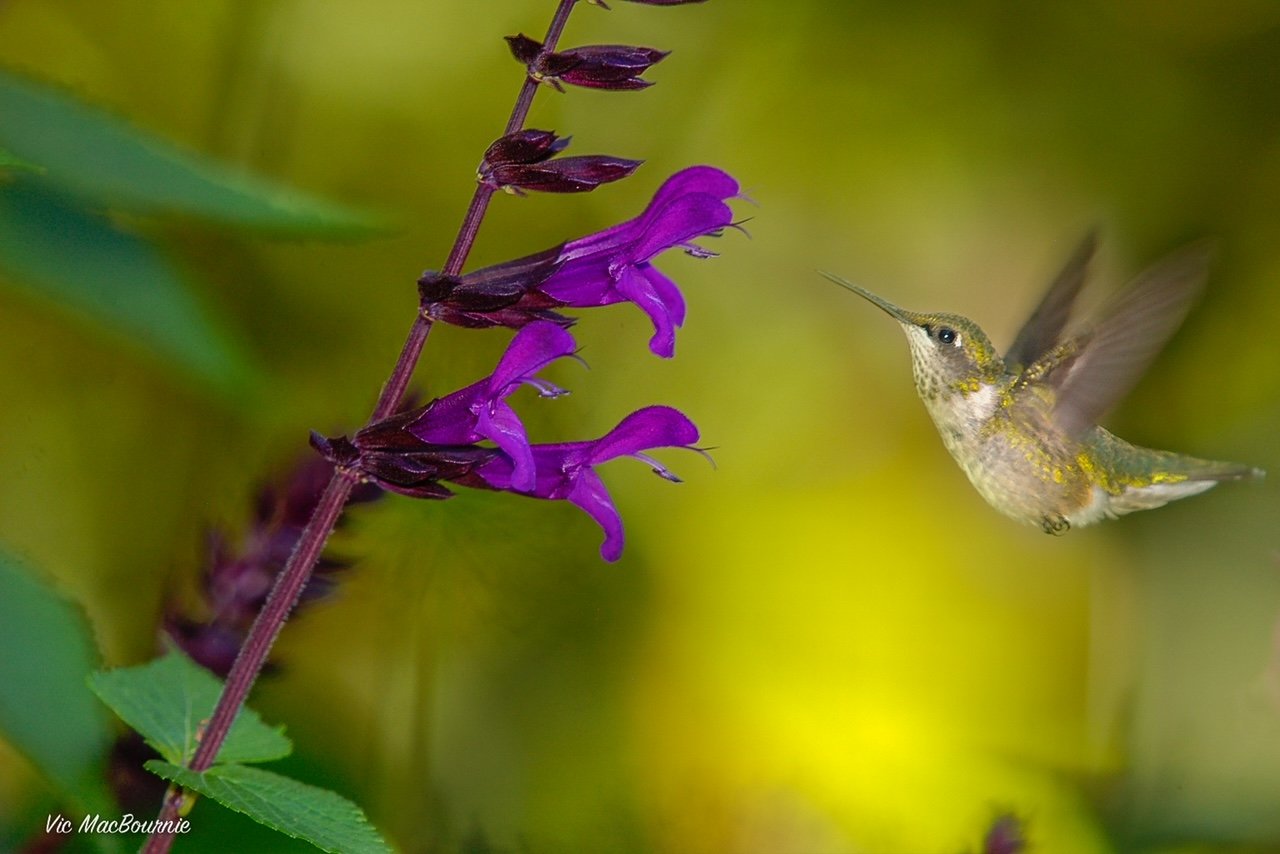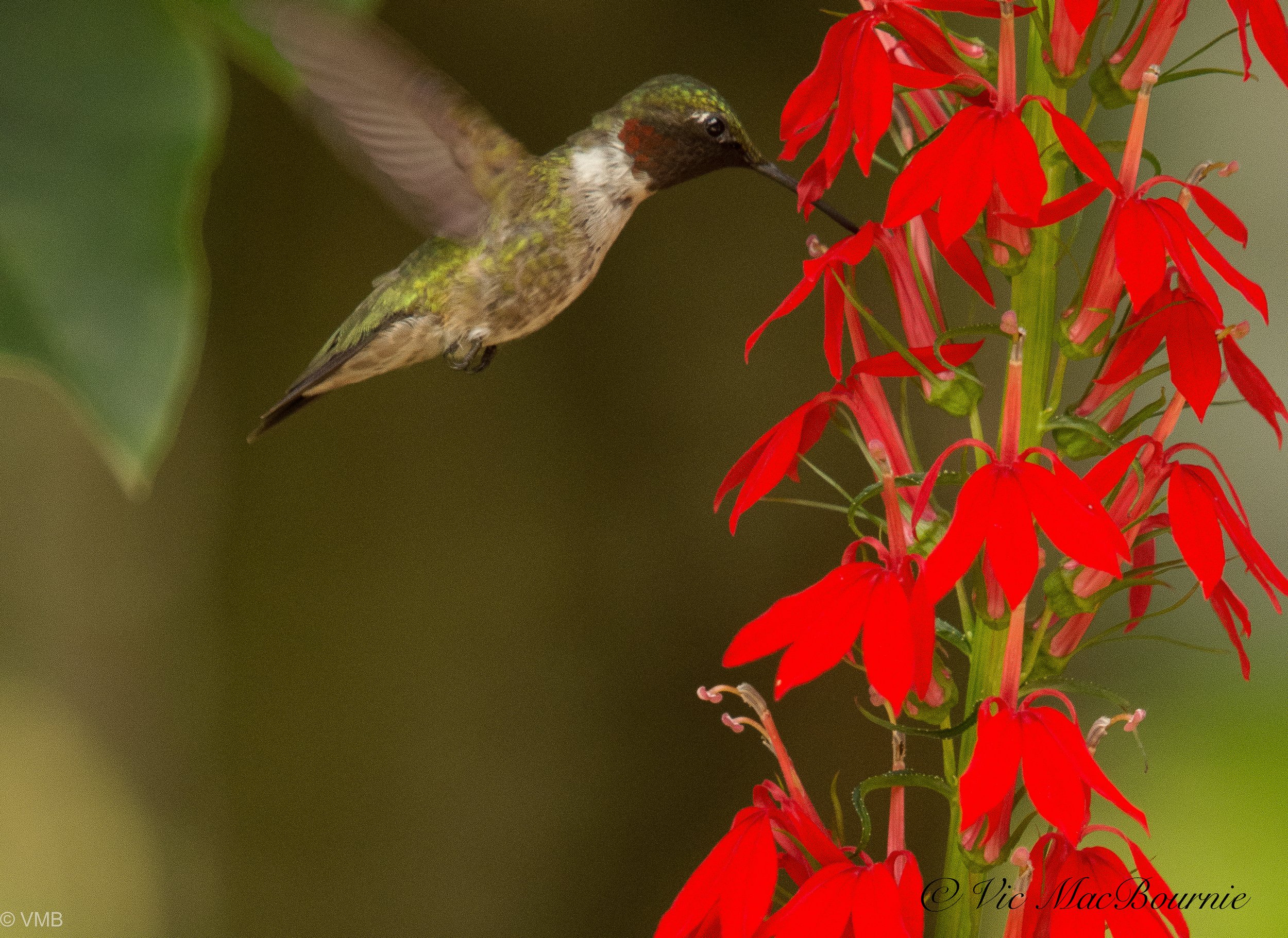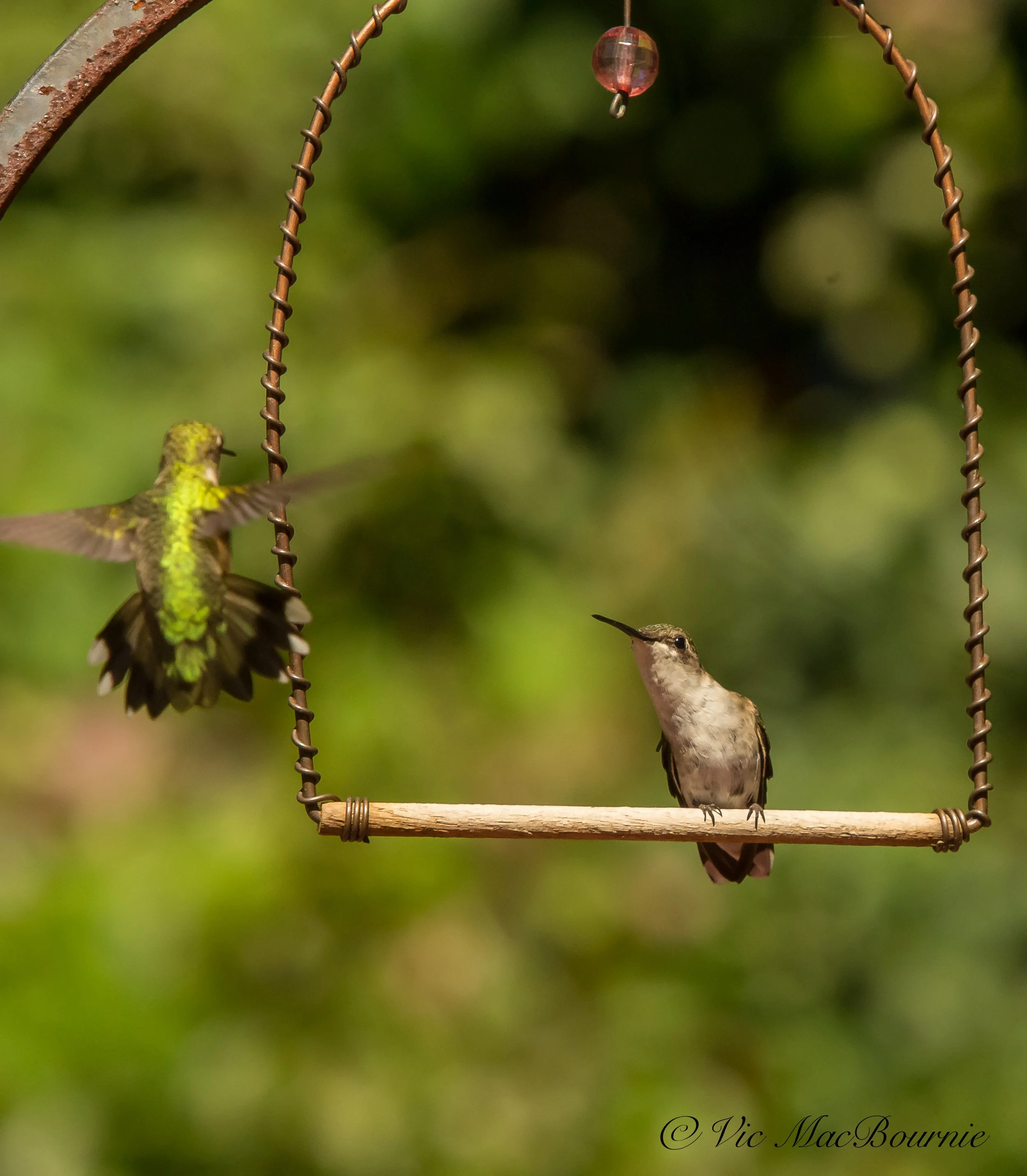What flowers attract hummingbirds?
Create a hanging basket for hummingbirds and butterflies
What flowers are best to attract hummingbirds?
And, can we use the information on these plants to create a hanging basket or container planting specifically for hummingbirds and butterflies?
Choosing the best nectar-producing flowers is key, but there are other factors that will add to your success.
While most gardeners focus on using hanging baskets as well as containers to simply add colour and maybe experiment with different textures, creating a hanging basket or container specifically for hummingbirds and butterflies requires a slightly different approach.
A full, beautiful basket with the typical thriller, spiller and fillers combination is not the prime goal of our container or hanging basket for hummingbirds. We can work toward that goal but don’t get too carried away with trying to achieve that effect. We are not necessarily going for pretty here, our goal is to attract hummingbirds and butterflies.
First, consider red as your primary colour choice. We are going hot here with a spot of strategic, cooler blue flowers.
If you are looking for a pastel-coloured hanging basket, chances are this is not going to work for you. Hummingbirds are particularly attracted to red, tubular flowers.
Obviously we have to consider the amount of sun our basket will receive and adjust the plants accordingly. In addition, we need to use plants that require similar conditions including both the amount of light and the amount of water required.
What hanging basket should I use for my hummingbird container?
First, let’s consider the importance of the hanging basket.
Forget those small store-bought white plastic baskets that you can purchase at any home improvement or garden centre. They can work if they happen to have some of the right hummingbird magnet plants included, but we want a hanging basket that maximizes our chances of attracting hummingbirds and butterflies while still looking good for the entire summer.
• For more Hummingbird images including digital images similar to the one below, click here.
Five great plants for Hummingbirds
Columbine native and hybrid forms
Cuphea or Vermillionaire
Calibrachoa
Supertunias
Verbena
A plastic container is good for holding water and maintaining a high moisture content. If you have a large one you want to use just make sure that you use enough “spillers” to quickly cover the unsightly plastic container.
Creating a beautiful, yet effective container is going to take a little work and a selection of some of the best flowers that are not usually included in the store-bought baskets.
A large wire basket with a coco mat tucked inside is an excellent starting point. Add a plastic liner that reaches 3/4 of the way up the inside of the container to hold the water and punch a couple of small holes in it, but just enough to allow the water to drain slowly.
If you want to add a little moss between the coco mat and wire frame, it will certainly enhance the look of your basket and help it hold moisture.
How many plants should we add?
For a 12- to 14-inch (diameter) basket you’ll want to have at least three to five plants, and for a 16- to 18-inch basket you’ll be adding at least five to seven plants. Don’t hesitate to add a few more to create a more full hanging basket but realize that you may have to water it more often and tidy it up later in the season.
Use a good quality potting soil in the baskets. You can add a handful of well-rotted compost to provide a little added natural nourishment. I recommend using a soil that includes slow release fertilizer and water retaining crystals in it, or be sure to add your own before you begin planting the containers up.
Plants that attract hummingbirds
Don’t be afraid to experiment with the flowers.
Consider planting up two different hanging baskets or, better still, a hanging basket and large container just for the hummingbirds.
Explore the use of native wildflowers to your area.
Hummingbirds and butterflies are already familiar with these plants and should come more readily to the baskets when they recognize the flowers in the container. Some of these native plants grow too large for planters but should work well in containers. You can also plant some of the larger ones, like Cardinal flower, below where you want to hang the baskets. By mid-summer the cardinal flowers will grow up high enough to blend in with the spillers and create a true hummingbird haven.
Remember, we are not aiming to win an award for the most beautiful containers and baskets, we are looking to create hummingbird magnets.
Complete list of plants that attract hummingbirds
Here is a list of plants that will attract hummingbirds and butterflies. Not all will be appropriate for hanging baskets but most would work in a large container.
Bee Balm (Monarda didyma) Unusual whorledd flowers in pink, red, white and red-purple. Fast spreader. Zones 4 to 10.
Catmint (Nepeta spp.) Loose mounding clumps of silvery leaves with abundant, small, lavender-blue flowers. Hardy in zones 3 to 10.
Columbines (Aquilegia spp.) Long-spurred flowers are held on bare stems above a rosette of pretty, lobed foliage. Most hardy in Zones 2 to 10.
Coral bells (Heuchera sanguinea) Rosettes of scalloped leaves bear many long-blooming stems of tiny red, pink or white blossoms. Remember red is ideal for hummingbirds. Zones 3 to 0.
Delphiniums (Delphinium) Beautiful spikes in all shades of blue, purple, and white rise above rosettes of foliage. Does best in cooler climates. Sones 3 to 10.
Hyssops (Agastache) Densely packed, narrow spikes of tiny flowers, often with fragrant foliage, are more familiar to herb gardens but beloved by hummingbirds. Zones 4 to 10.
Penstemons (Penstemon) Midheight perennials with abundant tubular flowers in blue, white and purple. Grows best in the West. They can be difficult to grow and are considered short-lived, but worthy of trying. Likes good drainage. Hardiness depends on species and varies from Zones 3 to 9.
Phlox (Phlox paniculata) Old-tiime garden favourite with often fragrant flowers in pink, red, white and lilac. Zones 3 to 9.
Pineapple sage (Salvia elegans) Large bush with fragrant foliage and late-blooming, bright red flowers. Zones 8 to 10. Can be grown as annual in cold regions.
Salvia (Salvia) Grows in Zone 8 but grown as annuals elsewhere. Has brilliant red flower. Cultivars are hummingbird magnets. Many are hardy in Zones 5 to 10, others only in the hottest Zones 9 to 10.
Annuals and tender perennials
Cleome (Cleome basslerama) Spidery whorls in pink, white and purple on 4-foot plants. Annual in all zones.
Four-o’clocks (Mirabilis jalapa) Bushy tuber forming tender perennials with flowers in red, yellow, white and pink – sometimes more than one colour on a single plant. Blooms in late afternoon. Gow as annual in most zones. Perennial in Zones 9 and 10.
Geraniums (Pelargonium x hortorum) Familiar container plants with pink, salmon, red, or white flowers. Anualls accept in Zones 9-10.
Geraniums, scented (Pelargonium) A wide asoortment of leaf shape and scent. Flowers are much less showy that common geraniums, but highly attractive to hummers. Annuals accept in Zones 9 to 10.
Impatiens (impatiens wallerana) Popular bedding annual with red, white, pink, lavender and mixed colours. Annuals in all but hottest Zones.
Nicotianas (Nicotiana) Sweet-smelling tobacco relatives with tubular blossoms. Avoid “Nikki” hybrids. Annuals accept in Zones 9 to 10.
Petunias (Petunia and hybrids) Popular annuals with sprawling plants and a variety of colourful flaring trumpet flowers. Annuals.
Tithonia (Tithonia rotundifolia) Huge, bushy but single-stemmed branching plant , to 8 feet high and 4 feet wide with a multitude of brilliant orange-red daisylike flowers in late summer. Also attracts variety of butterflies. Annual in all zone.
Thrilling possibilities with native plants
In a large container, consider using a native, red and yellow columbine as a thriller in the middle of the basket or container. Adding a good performing hybrid columbine such as this early blooming “early bird red and white columbine (Proven Winners) combined with the company’s Songbird Cardinal red and white columbine will help ensure a prolonged blooming period from early spring, when the hummers start appearing, to later in the summer.
The blue and yellow varieties will work as well and provide a little more colour to the basket. The columbines, both native and hybrids, will grow tall and form a solid thriller to attract hummingbirds.
In the fall, be sure to replant the native columbine in your garden to ensure it blooms again for future years.
Another favourite red-flowered plant to attract hummingbirds is the Cuphea Vermillionaire, (link to Proven Winners site) often referred to as the Firecracker Plant. This annual can be grown in a pot or in the ground and likes full sun. Keep it well watered and fertilized and it will send out its long cigar-like red flowers throughout the summer.
It can get quite large growing upwards to two feet high with a 12- to 24-inch spread, so it too might be best in a large container. But it can be kept in check in a larger hanging basket and used as a thriller or spiller (if planted horizontally in the basket). Keep it in check with a little pruning.
Other plants to consider for your Hummingbird hanging basket
Calibrachoa (Proven Winners) is an outstanding performer in a container or hanging basket. Proven Winners calls them “Superbells” and they offer several pages on their website. (see link) This annual likes sun to part sun and is often used all by itself in store-bought hanging baskets. It can look very impressive in the basket by itself but, remember, pretty is not the end goal here. They are available in a wide range of colours from hot reds and fuschias to cool blues and purples as well as combinations of yellow/pink, peach/purple… Stay away from double varieties and lean to the hot colours for best results.
Supertunias are Proven Winners’ improved version of the petunia and are available in a host of sizes colours and combinations. I have used the vista series for several years. Bubblegum is a pink variety that blooms continuously all summer and fills the basket quickly. Bordeaux is a smaller version (purple and white) that works nicely in hanging baskets and containers.
Verbena is another excellent choice to and a good one to use as a thriller. Varieties such as Meteor showers have a more compact growth habit for use in containers and baskets.
Salvias are top performers when it comes to attracting butterflies, hummingbirds and bees. I can personally attest to the effectiveness of Rockin’ Deep Purple in container plantings after using it last year and getting non-stop action.
Fuschsia, whether the regular hardy varieties seen in most nurseries or Cape Fuchsia with its more tubular flowers resembling Cupheas, are excellent choices for spillers in your baskets or containers. They do well in filtered light and are intollerant of high heat. Keep them well watered and out of full sun and they will perform admireably.
Native Lobelia (siphilitica) is another great addition to the garden and irresistible to hummingbirds and butterflies. This native hardy perennial would need to be planted out in the garden in fall to enjoy year after year.
Native lobelias would best be used as thrillers on account of how tall they grow. Their bright blue flowers will bloom in late summer and the plants are well-known for their ease of care and versatility. Unlike many of the annual lobelias commonly used in baskets as fillers, these lobelias can grow much larger – up to 4 feet. This is another plant I grew last year in our garden. Although it stayed around 2-feet high it can get quite large for a small basket. A large container might be a better solution, but it may work as a thriller in a large basket.
Add these accessories for even greater success
If you have not had much success attracting hummingbirds or a lot of butterflies, you might need a little help beyond the hanging baskets and containers.
Consider adding a perch or swing for your hummingbirds
Try hanging a small commercially available hummingbird perch or swing near the hanging basket/container. In fact, two perches is probably even better and will give the hummingbirds options to rest. Try placing one in the open and another tucked away in a nearby tree or shrub.
Go here for my complete story on using hummingbird swings.
I have used a swing for a number of years and once the hummers discover them, the perches quickly become a favourite spot for them to watch over their favourite feeding area.
Add a small hummingbird feeder
Small tubular hummingbird feeders are available with a wire stick that allows you to add them to your hanging planters and containers. These smaller versions of the larger hanging feeders can be tucked away in the planters where they almost become invisible to all but the hummingbirds who zero in on them.
A mister or shallow fountain will give them another reason to hang out
Hummingbirds, like all birds and wildlife, enjoy bathing but they need shallow water or, even better, a light mist to feel safe. Misters and shallow fountains are available at birding stores, Amazon and other commercial locations. You can also make your own with a shallow dish and a small solar pump with a fountain attachment.
Be sure to keep the water clean for these little guys and they will reward you with their antics all summer.





